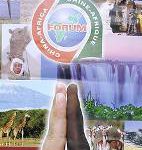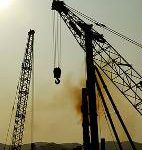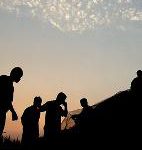The first sandstorm of autumn 2006 blew up in Alashan’s Left Banner, an administrative division of Inner Mongolia, on August 27. Alashan (or Alxa), in the far west of this autonomous Mongol region of China, has been the focus of considerable attention in recent years for just that reason: it is one of the sources of Asia’s sandstorms.
Official data show that Alashan’s desert area expanded from 92.71% of its total land in 1996 to 93.14% in 2004, an increase of 0.43 percentage points — and every tenth of a point represents another 200 square kilometres of infertile land. Alashan’s three deserts — the Badain Jaran, the Tengger and the Ulan Buh – are gradually merging, already meeting in three places in Left Banner and four in the Right Banner locality.
“Increasing numbers of both people and livestock, and over-development of agriculture, are at the root of Alashan’s environmental degradation,” says Tsang Buch, chief of the Alashan League Forestry and Desert-Control Bureau.
Historical data put Alashan’s population during the early years of the People’s Republic (founded in 1949) at a little less than 35,000. Now, it is 212,000 – a six-fold leap (in contrast to a 2.4-fold population increase nationally over the same period).
Due in large part to pre-1949 conscription by warlords in Ningxia and the famines of the 1950s and ’60s, an influx of outsiders — of different ethnicity — moved into Alashan. They had an unprecedented impact on Alashan’s grassland culture, and the population growth led to an increase in the number of livestock.
Currently, the ideal livestock population for the league’s grasslands would be the equivalent of 700,000 sheep, but figures from July 2006 show that the actual figure is equivalent to two million sheep. And yet the herdspeople believe even that figure is an underestimate. In the 1990s, the village of Helan in Left Banner raised 30,000 sheep, but government statistics showed only a third of that number.
To relieve pressure on the grasslands and allow the environment to recover, Alashan launched a succession of large-scale relocations of its inhabitants to the newly founded towns of Xitan and Manshuitan in Left Banner in 1989. The keeping of livestock was banned in the areas from which the people were moved.
In January 1995, the league’s then-party secretary, Fu Laiwang, put forward a “relocation strategy” consisting of moving herders from their pastures to oases and towns to work in the private sector. Official reports show that, to the end of 2005, the league had relocated 19,082 people, and plans for 2006-10 will see a further 21,754 moved. That means that by 2010, 40,836 people — 20% of the 2005 population of 212,000 and 80% of the herding population – will have been relocated.
But solving the environmental issues has given rise to new social problems. The relocations have left large numbers of former herders in poverty.
In 1999, the Left Banner government decided to reforest pastures in the Helan Mountain Nature Reserve and relocate the local population. Some 6,000 locals were moved, 230,000 head of livestock disposed of and 230 acres of land converted.
Each relocated person received an RMB 500 resettlement allowance, with compensation of RMB 1,000 for each sheep pen demolished, RMB 140 per square metre for brick houses and RMB 100 per square meter for mud houses. (The RMB is now valued at roughly 7.8 to the US dollar.) Those in the first two rounds of relocation received RMB 4.95 per mu (one-fifteenth of a hectare) of land per year, for five years. In the third round, in 2001, that RMB 4.95 was replaced with 5.5 kilograms of past-its-best grain. After relocation, the herders – now farmers – made most of their income from planting crops, but (including compensation) only earned one third of their original incomes.
When I visited Sumurtuu Gacha, former herder Tumurbaatar was tending to the chickens in his yard. He said that, on leaving the grasslands in 2005, his family had sold 400 head of sheep and has relied since then on government subsidies to survive. His family of seven will receive over RMB 100,000 in compensation annually, for a five-year period.
Tumurbaatar worries about the future. “What happens in five years? We’re not allowed to herd, and we’ve no land to farm. The government hasn’t arranged any work for us. All we can do is raise a few chickens and ducks. The village is full of people like us.”
Yang Mudan, deputy professor of economics at Alashan’s communist party school, stressed the problem of herders returning, or even becoming vagrants. A 2004 Environmental Quality Evaluation in Alashan found 34,000 herders living below the poverty line, with 4,700 in absolute poverty. Many areas were no longer able to support either man or livestock, and 20,000 herders had moved away, become environmental refugees.
The deputy governor of Alashan, Gong Jiadong, admits that “ensuring work for the herders is essential for successful relocation. Simply handing out compensation doesn’t work.”
Alashan’s administrative office decided to focus on encouraging private businesses to absorb those who are relocated. In early 2006, the “relocation strategy” was adjusted, with the focus shifting from oases to towns and cities. At the same time, Alashan’s drive towards urbanisation and industrialisation become more apparent.
“Economic growth in Alashan is quite fast, 30% a year on average,” according to the head of Alashan’s Environmental Testing Station, Taao Gerrela. “Most of that growth comes from industry.” A further 21,754 people are to be moved for environmental reasons between 2006 and 2010, but Yang Mudan believes it is still not certain that Alashan’s economy can absorb them.
Meanwhile, rapid industrialisation is causing more pollution and damaging the environment. Severe pollution has lead to Alashan’s industrial centers – the towns of Lantai and Wusitai in Left Banner – being placed under strict supervision by the State Environmental Protection Administration and the Ministry of Land and Resources. The 600-kilometre journey from Bayan to Ejina Banner runs almost entirely through desolate gravel and sand desert.
How should the successes and failures of environmental policy in Alashan be explained?
Grasslands expert Liu Shurun is firmly opposed to enclosures and relocations, believing that it is not beneficial to the grass, to the people or the livestock – it is simply moving from one extreme to another. “Livestock, in appropriate numbers, are good for the grasslands – you can’t have grasslands without them,” he says.
Sheep eat 700 types of grass, and livestock eating and walking on the grass both stimulates growth and controls it. It is not harmful, and without animal activity, the grass grows out of control. Also, after enclosure, grasslands are no longer fertilised by livestock excrement and over time only one or two species of grass will survive, homogenising that population.
Liu points out that inappropriate environmental policies are a result of a farming nation’s failure to appreciate herding culture — an unthinking application of Han Chinese experience. The enforced practice in Alashan can only be ascribed to government ignorance and an unchecked spread of the popular view of development. Liu goes as far as to say that herding has been the natural choice in Alashan for thousands of years, and that grassland society should be restructured around a nomadic system.
“For years now,” said the Alashan SEE Ecology Association’s deputy secretary, Deng Yi, “the government has been doing its utmost to protect the environment, but you can see that when separating people and the environment in order to allow the environment to recover is very effective. When livestock is kept out by fences, the pressure on nature is lessened. In fact, that fence is dead and people are alive, camels are big and sheep are small – that is to say, you can’t change people, and if the herders’ behaviour doesn’t change, any measures will only be for show.”
Song Jun, deputy head of the ecology association, believes that the scarcity of government successes in environmental protection is due to the top-down nature of implementation. The government designs the rules of the game and implements the projects – but it is not an interested party, a stakeholder.
Song believes that environmental protection should be commercialised, with interested parties identified, the government putting preferential policies in place, and environmental protection then implemented by the market. The herders should also participate, becoming beneficiaries of the ecology industry.
Zhou Jigang, formerly of Economy magazine and Hong Kong’s Phoenix Weekly, focuses on in-depth reporting about macroeconomics and current affairs. His investigations into radioactive pollution in Baotou and China’s underground industries both caused considerable controversy in China.



